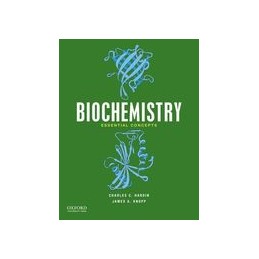Description
One-semester biochemistry courses are notorious for overwhelming students with the magnitude of material covered in their texts and lectures. Biochemistry:: Essential Concepts distills the basic ideas covered in a one-semester course without the extraneous details that burden most texts. Authors Charles Hardin and James Knopp demonstrate the core concepts of biochemistry - including cell biology, amino acids, metabolism, and DNA - in a variety of real-world contexts. With the last forty percent of the text devoted to review questions and practice tests, Biochemistry:: Essential Concepts equips students for success in the one-semester biochemistry course and prepares them for their future studies and careers.
Product Details
Reference
86975
EAN13
9780199765621
ISBN
9780199765621
Data sheet
Publication date
2012
Issue number
1
Cover
paperback
Pages count
336
Dimensions (mm)
216 x 279
Weight (g)
839
Brief Contents; Preface; Acknowledgement; Chapter 1. Biochemistry: Subject Overview; 1.1 Central Themes; 1.2 Central Dogma of Molecular Biology; Chapter 2. Cell Biology Review; 2.1 The Animal Cell; 2.2 The Plant Cell; 2.3 Selected Organelles; 2.4 The Cell Cycle: Mitotic Cell Division; 2.5 Viruses; Chapter 3. Chemistry Review; 3.1 Organic Compounds; 3.2 Chirality; 3.3 Chemical Reactions; 3.4 Physical Chemistry Concepts; 3.5 Buffering of Blood: The Bicarbonate System; Chapter 4. Amino Acids; 4.1 Basic Structures; 4.2 Amino acid R Groups; 4.3 Ionization Properties; 4.4 Drawing Peptide Titration Plots; 4.5 Factors That Influence the pKa of Protonatable/Deprotonatable Groups in Proteins; Chapter 5. Proteins; 5.1 Peptide Bonds; 5.2 Purification and Characterization of Proteins; Chapter 6. Protein Structure; 6.1 Conformation; 6.2 Classification of Substructure; 6.3 Alpha (?) Helices; 6.4 Beta Sheets; 6.5 U-Turns; 6.6 Ramachandran Plot; 6.7 Stabilizing Factors; 6.8 Thermodynamics of Protein Folding: The Hydrophobic Effect; 6.8.1 Temperature-Dependant Denaturation; 6.9 Chaotropes and The Hofmeister Series; 6.10 Sodium Dodecyl Sulfate (SDS): Chaotrope Action; 6.11 Visualizing the Energy Landscape; 6.12 Protein Maturation; Chapter 7. Ligand Binding and Functional Control; 7.1 Oxygen Transport in Blood; 7.2 Hemoglobin Oxygen Binding: Cooperativity; 7.3 Antibodies: Immunological Recognition; Chapter 8. Enzymes; 8.1 Enzymes are Biological Catalysts; 8.2 Enzyme Function: Activity Assays and Enzyme Kinetics; 8.3 Requirements for Catalysis; 8.4 Comparing Enzymes and Relative Efficiency of Use of Substrates; 8.5 Drug Design; 8.6 Enzyme Inhibitors; 8.7 Allosterism; 8.8 Phosphorylation and Dephosphorylation; Chapter 9. Metabolic Enzyme Action; 9.1 Enzyme Mechanisms; 9.2 Modes of Catalysis; 9.3 The Reaction Coordinate; 9.4 Induced Fit Revisited; 9.5 Acid-Base Catalysis; 9.6 Covalent Group Transfer; 9.7 The Serine Protease Catalytic Triad Mechanism; 9.8 The Active Site of Tyrosyl-tRNA Synthetase; Chapter 10. Coenzymes; 10.1 Classification; 10.2 Survey of the Coenzymes; 10. 3 Metals; 10.4. Carbohydrates-Based Cofactors; 10.5 Fat Soluble Vitamins; Chapter 11. Carbohydrates and Glycoconjugates; 11.1 Carbohydrates: Definition; 11.2 Monosaccharides: Aldoses; 11.3 Monosaccharides: Ketoses; 11.4 Structural Features; 11.5 Intramolecular Cyclization; 11.6 Conformations: Sugar Puckers; 11.7 Sugar Derivatives; 11.8 Disaccharides; 11.9 Polysaccharides; 11.10 Carbohydrate-Protein Conjugates; 11.11 Synthesis and Structural Characterization; Chapter 12. Lipids; 12.1 Structural Overview; 12.2 Saturated and Unsaturated Fatty Acids; 12.3 Functions; 12.4 Diacylglycerol Lipid Derivatives; 12.5 Structural Motifs; 12.6 Assembly; 12.7 Structural and Dynamic Characterization; 12.8 Eicosanoids; 12.9 Phospholipases; 12.10 Phosphoinositides; 12.11 Steroids; 12.12 A Potpourrie of Lipids; Chapter 13. Membranes; 13.1 The Fluid Mosaic Model; 13.2 Detergents; 13.3 Distribution of Lipids in Biological Membranes; 13.4 The Hydropathicity Scale; 13.5 Lipid-Anchored Membrane Proteins; 13.6 The Erythrocyte Cytoskeleton; Chapter 14. Transport Through Membranes; 14.1 The Transmembrane Potential; 14.2 Active Transport; 14.3 Ionophores; 14.4 The Acetylcholine Receptor Ion Channel; 14.5 Lactose Permease and Secondary Active Transport; 14.6 Mechanism of Transport by Na+, K+ ATPase; 14.7 Ion Channel Blockers; Chapter 15. Signal Transduction; 15.1 Signaling Pathways: Hormones, GTPases, Second Messengers and Intracellular Regulation .. 120; 15.2 The Adenylate Cyclase Signaling Pathway; 15.3 The Inositol-Phospholipid Signaling Pathway; 15.4 Phorbol Myristyl Acetate; 15.5 The Insulin Receptor; 15.6 Glucagon; 15.7 G-Proteins; Chapter 16. Nucleic Acids: DNA; 16.1 DNA and RNA; 16.2 Physical Properties; 16.3 Secondary Structure; 16.4 Backbone Structure; 16.5 Counterions; 16.6 Chemical Synthesis; 16.7 Watson-Crick Base Pairs; 16.8 Structural Modifications; 16.9 Three-Dimensional Structures; 16.10 Recognition of Sequences; 16.11 Genetic Mutations and Antisense Nucleic Acids; 16.12 Unusual DNA; 16.13 Stabilization of Nucleic Acids; 16.14 Secondary Structure Predictions; 16.15 Chromosomes; 16.16 Some Protein Nucleic Acid Binding Motifs; 16.17 Recombination; Chapter 17. RNA; 17.1 Cells Contain a Variety of Types of RNA; 17.2 RNAs Have Stable Secondary Structure; 17.3 Tertiary Structure: Transfer RNA; 17.4 Messenger RNA (mRNA); 17.5 Eukaryotic Messenger RNA; 17.6 Alkaline Hydrolysis of RNA; 17.7 Small Interfering RNA; Chapter 18. Biotechnology; 18.1 Restriction Endonucleases; 18.2 Cloning in a Nutshell; 18.3 DNA Preparation: Phenol-Chloroform Extraction; 18.4 Polymerase Chain Reaction; 18.5 Probe DNA; Chapter 19. Metabolism; 19.1 Overview; 19.2 Metabolic Pathway Types; 19.3 Energy Conservation; 19.4 Key Pathways/Reactions; Chapter 20. Bioenergetics; 20.1 Reaction Equilibria: Standard and Actual Free Energies; 20.2 Metabolically Irreversible and Near Equilibrium Reactions; 20.3 Energies and Regulation of Glycolysis; Chapter 21. Bioelectrochemistry; 21.1 Redox Reaction Principles; 21.2 Redox Energetics: The Nernst Equation; 21.3 Electron Transport Chains; Chapter 22. Glycolysis; 22.1 Reactions 1 Through 10; 22.2 Regulation: Activation and Inhibition; 22.3 Four Fates of Pyruvate; Chapter 23. The Krebs Cycle; 23.1 Pathway; 23.2 Reactions; 23.3 Yields; 23.4 Cellular Redox Potential; 23.5 Regulation; Chapter 24. Gluconeogenesis; 24.1 Reactions; 24.2 Regulation; 24.3 Sources Used to Produce Glucose; Chapter 25. Electron Transport and Oxidative Phosphorylation; 25.1 Mitochondria in Red and White Muscle; 25.2 Overall Process; 25.3 Chemical and Potential Energies That Drive Proton Transport; 25.4 Mitochondrial Electron Transport; 25.5 Electron Transfer and Proton Flow in Complexes I through IV; 25.6 Oxidative Phosphorylation; Chapter 26. The Malate-Aspartate Shuttle and Proteomics; 26.1 Getting NADH Into the Mitochondrion: Isozymes; 26.2 Isozymes and Proteomics; 26.3 Characterization by Two-dimensional Gel Electrophoresis; 26.4 Mass Spectrometry and Proteomics; Chapter 27. Degradation and Synthesis of Lipids; 27.1 Beta Oxidation of Saturated Fatty Acids; 27.2 Biosynthesis of Fatty Acids; 27.3 Length Determination of Fatty Acids; 27.4 Synthesis of Acidic Phospholipids; 27.5 Cholesterol Biosynthesis; 27.6 Regulating Cholesterol Levels; Chapter 28. Photosynthesis; 28.1 Light and Dark Reactions; 28.2 Photo-Gathering Pigments; 28.3 Photosynthetic Electron Transport Pathway (Z scheme); Chapter 29. The Calvin Cycle; 29.1 The Dark Reactions: Carbon Fixation; 29.2 Biosynthesis of Ribose-5-phosphate; 29.3 RuBisCO Mechanism; 29.4 The C4 and CAM Pathways; Chapter 30. The Urea Cycle; 30.1 Purpose and Reactions; 30.2 Regulation; 30.3 Comparative Nitrogen Excretion; 30.4 Protein Degradation and Programmed Cell Death; STUDY GUIDE; Review Session for Chapters 1 - 3; Review Session for Chapter 4; Review Session for Chapters 5 and 6; Review Session for Chapters 7 - 8.6; Review Sessions for Chapters 8.7 - 8.8; Review Session for Chapter 9; Review Session for Chapters 10 - 11.4; Review Session for Chapters 10 - 11.4: Key; Review Session for Chapters 11.5 - 12.5; Review Session for Chapters 11.5 - 12.5: Key; Review Session for Chapters 13 - 14.7; Review Session for Chapters 13 - 14.7: Key; Review Session for Chapters 16.2 - 17.6; Review Session for Chapters 16.2 - 17.6: Key; Review Session for Chapters 19 - 20; Review Session for Chapters 19 - 20: Key; Review Session for Chapters 21 - 25; Review Session for Chapters 21 - 25: Key; Review Session for Chapter 27; Review Session for Chapter 27: Key; Practice Exam 1, Key; Practice Exam 2, Key; Practice Exam 3, Key; Practice Exam 4, Key; Final Test Review; Final Test Review (with answers);




 Delivery policy
Delivery policy
 Security policy
Security policy
 Return policy
Return policy
